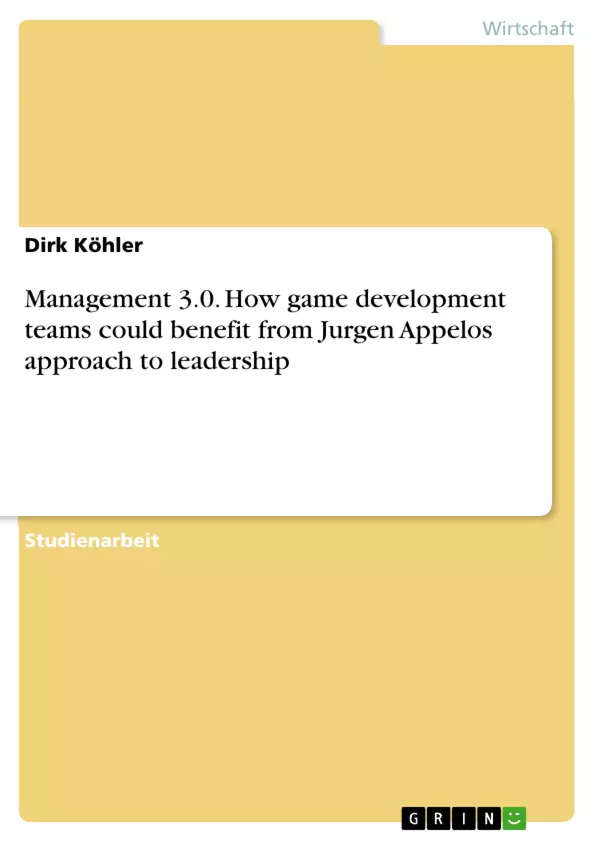This assignment will give a brief overview about the approach of Management 3.0 from Jurgen Appelo and how leaders and members of game development teams could benefit from it.
Developing computer games is almost as old as the development of classic software. There are many similarities, and at the end, the result is the same: a program that runs on a computer. But teams which are developing computer games were growing much faster over the decades than classic software development teams. Also the complexity itself was increasing rapidly.
The reason: Additional resources were needed besides programmers. These include for example, graphic artists, game designer, game balancer, visual effects specialists and even people who are doing the music and sounds. Being a leader for this kind of interdisciplinary team with creative and analytical people inside is often a bigger challenge than doing it for a homogenous group of people from one profession.
Inhaltsverzeichnis
- Introduction
- Agile development and leadership
- The Evolution of software engineering
- Agile teams and leadership
- The Management 3.0 approach
- Leadership, Structures and Workflows at Goodgame Studios
- The six views of Management 3.0 on Goodgame Studios
- Energize People
- Empower Teams
- Align Constraints
- Develop Competence
- Grow Structure
- Improve Everything
- Conclusion
Zielsetzung und Themenschwerpunkte
Diese Arbeit untersucht den Management 3.0 Ansatz von Jurgen Appelo und seine potenziellen Vorteile für die Führung von Spieleentwicklungsteams bei Goodgame Studios. Sie analysiert die Herausforderungen von interdisziplinären Teams in der Spieleentwicklung und untersucht, wie Management 3.0 dazu beitragen kann, diese Herausforderungen zu bewältigen.
- Die Evolution der Softwareentwicklung und der Aufstieg agiler Methoden
- Die Rolle von Leadership und Teamdynamik im agilen Umfeld
- Die sechs Säulen von Management 3.0 und ihre Anwendung auf Goodgame Studios
- Die Vorteile des Management 3.0 Ansatzes für die Motivation und Kompetenzerweiterung von Teams
- Die Optimierung von Arbeitsabläufen und Strukturen mithilfe des Management 3.0 Ansatzes
Zusammenfassung der Kapitel
Die Arbeit beginnt mit einer Einführung in die Entwicklung von Computerspielen und den Vergleich zur klassischen Softwareentwicklung. Sie beleuchtet die wachsende Komplexität von Spieleentwicklungsteams und die Herausforderungen der Führung interdisziplinärer Gruppen. Kapitel 2 beleuchtet die Evolution der Softwareentwicklung und die Entwicklung agiler Methoden. Es beleuchtet die Agile Manifesto und die Werte, die hinter dieser neuen Vorgehensweise stehen. Kapitel 2.2 befasst sich mit den Eigenschaften von agilen Teams und der Bedeutung von Leadership für die Motivation und das Verhalten der Teammitglieder. Das Kapitel behandelt auch die Management 3.0 Methode, die eine neue Form des Führungsstils vorschlägt, der besonders gut für agile Teams geeignet ist.
Kapitel 3 widmet sich den Strukturen und Arbeitsabläufen bei Goodgame Studios und beleuchtet die spezifischen Herausforderungen der Spielentwicklung in diesem Unternehmen. Kapitel 4 stellt die sechs Säulen von Management 3.0 vor und zeigt, wie diese auf Goodgame Studios angewendet werden können. Dieses Kapitel untersucht die konkreten Maßnahmen, die Unternehmen ergreifen können, um Mitarbeiter zu motivieren, Teams zu befähigen, Einschränkungen zu bewältigen, Kompetenzen zu entwickeln, Strukturen zu wachsen und kontinuierliche Verbesserung zu fördern.
Schlüsselwörter
Die Arbeit fokussiert auf Themen wie agile Softwareentwicklung, Management 3.0, Leadership, Teamdynamik, Motivation, Spieleentwicklung, Goodgame Studios, interdisziplinäre Teams, Kompetenzerweiterung und Arbeitsabläufe.
- Citation du texte
- Dipl.Ing. (FH) Dirk Köhler (Auteur), 2016, Management 3.0. How game development teams could benefit from Jurgen Appelos approach to leadership, Munich, GRIN Verlag, https://www.grin.com/document/345155



